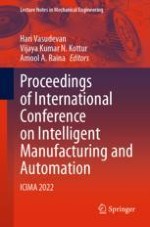The book comprises of selected papers presented at the Third International Conference on Intelligent Manufacturing and Automation (ICIMA 2022), which was organized by the Departments of Mechanical Engineering and Production Engineering of Dwarkadas J. Sanghvi College of Engineering (DJSCE), Mumbai, jointly with Indian Society of Manufacturing Engineers (ISME). The book focuses on specific topics of Intelligent Manufacturing, Automation, Advanced Materials and Design. It includes original research articles, focusing on the latest advances in the fields of Automation, Mechatronics & Robotics, CAD/CAM/CAE/CIM/FMS in Manufacturing, Artificial Intelligence in Manufacturing, IOT in Manufacturing, Product Design & Development, DFM/DFA/FMEA, MEMS & Nano Technology, Rapid Prototyping, Computational Techniques, Nano & Micro-machining, Sustainable Manufacturing, Industrial Engineering, Manufacturing Process Management, Modelling & Optimization Techniques, CRM, MRP & ERP, Green, Lean & Agile Manufacturing, Logistics & Supply Chain Management, Quality Assurance & Environment protection, Advanced Material Processing & Characterization and Composite & Smart Materials. It is hoped that the contents in the book will serve as reference for future researchers. The book is also expected to act as a valuable resource for the students of Post Graduate and Doctoral Programmes.
